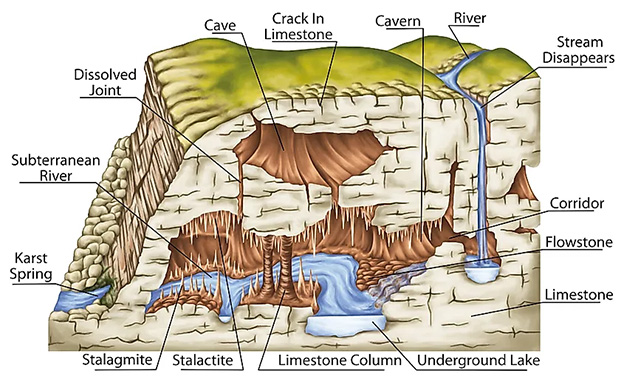- Filter By :
- Geography
- History
- Indian Heritage & Culture
- Indian Society
-
Q. What is karst topography? Describe its characteristics and significance. (250 words)
24 Apr, 2023 GS Paper 1 GeographyApproach
- Start your answer with a brief introduction about the karst topography.
- Discuss the characteristics and significance separately.
- Conclude accordingly.
Introduction
- Karst topography is a type of landscape that is formed by the dissolution of soluble rocks such as limestone, dolomite, and gypsum. Conditions that promote karst development are well-jointed, dense limestone near the surface; moderate to heavy rainfall; and good groundwater circulation.
- This unique topography is characterized by sinkholes, disappearing streams, caves, and underground drainage systems.
- Karst topography is found in many regions around the world and has significant ecological, geological, and human importance.
Body
Characteristics of Karst topography
Erosional landforms that characterize karst topography:
- Sinkholes:
- Sinkholes are circular depressions in the ground that are formed when the overlying soil and rock collapse into underground cavities.
- Caves:
- Caves are underground chambers and passages that are formed by the dissolution of rock. These can range from small cavities to large, complex systems that span many miles.
- Mammoth Cave National Park, Kentucky, USA:
- This park is home to the world's longest known cave system, with over 650 km of explored passageways.
- Lapies:
- It is formed due to differential solution activity along parallel to sub-parallel joints.
- They are also called grooved, fluted and ridge-like features in an open limestone field.
Depositional landforms that characterize karst topography:
- Stalactite:
- A portion of the roof hangs on the roof and on evaporation of water, a small deposit of limestone is left behind contributing to the formation of a stalactite, growing downwards from the roof.
- Stalagmite:
- The remaining portion of the drop falls to the floor. This also evaporates, leaving behind a small deposit of limestone aiding the formation of a stalagmite, thicker and flatter, rising upwards from the floor.
- Column:
- Sometimes, stalactite and stalagmite join together to form a complete pillar known as the column.
- Ha Long Bay, Vietnam:
- This UNESCO World Heritage Site is known for its tower-like limestone formations, which are formed by Karst Topography.
Other Characteristics:
- Disappearing Streams:
- Disappearing streams are streams that flow into the ground and disappear into underground drainage systems.
- Underground Lake:
- Most naturally occurring underground lakes are found in areas of Karst topography, where limestone or other soluble rock has been weathered away, leaving a cave where water can flow and accumulate.
Significance of Karst Topography:
- Geological Significance:
- The dissolution of soluble rocks results in the formation of complex underground drainage systems, which can lead to the creation of vast cave systems.
- These caves can contain important geological formations, such as stalactites, stalagmites, and flowstones, which provide insights into the Earth's geological history.
- Human Significance:
- Many karst regions around the world are used for agriculture and forestry, and they provide important sources of raw materials, such as limestone for construction.
- However, human activities can also have negative impacts on karst ecosystems, such as groundwater contamination and soil erosion.
- Ecological Significance:
- It provides habitats for a diverse range of plant and animal species, many of which are unique to karst environments.
- The porous nature of the rock formations allows water to seep through and form underground aquifers, which provide important sources of freshwater for drinking, irrigation, and industry.
Conclusion
- Karsts are found in widely scattered sections of the world, including the caucus of France; the Kwangsi area of China; the Yucatan Peninsula in the United States. Human activities have negative impacts on karst ecosystems, and it is important to protect and preserve these fragile landscapes.
To get PDF version, Please click on "Print PDF" button.
Print PDF





